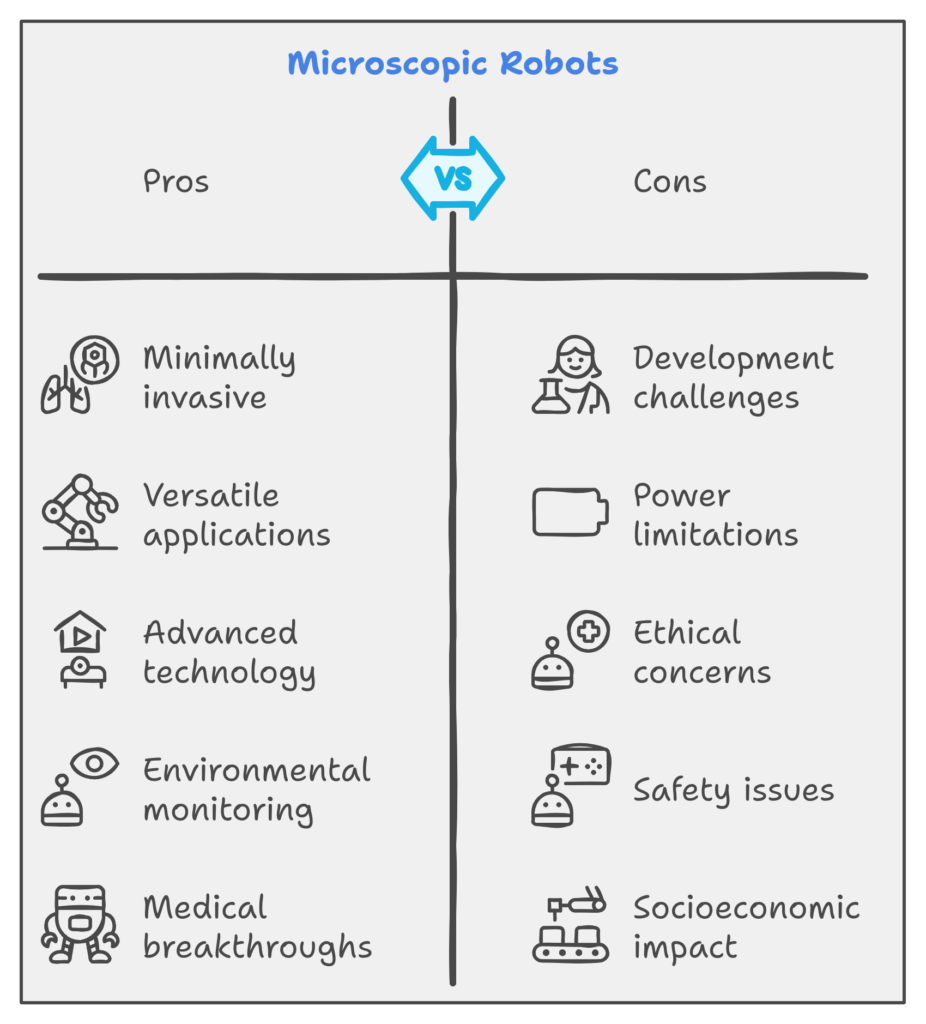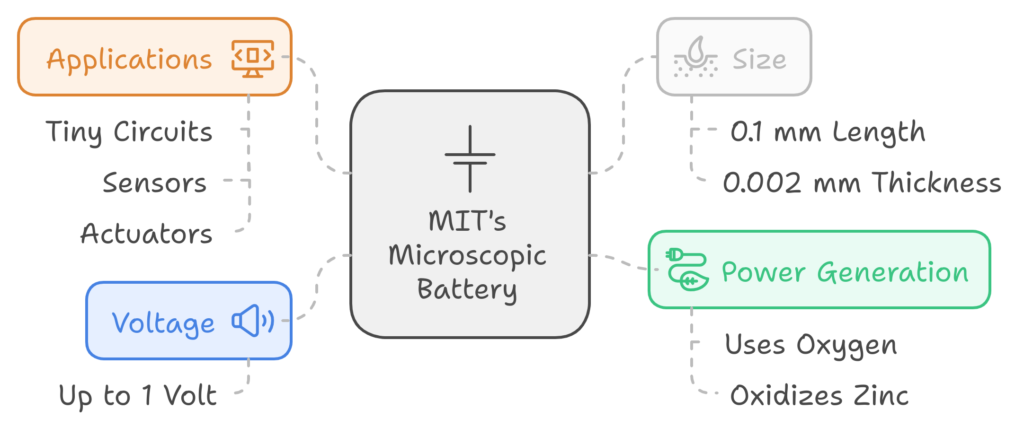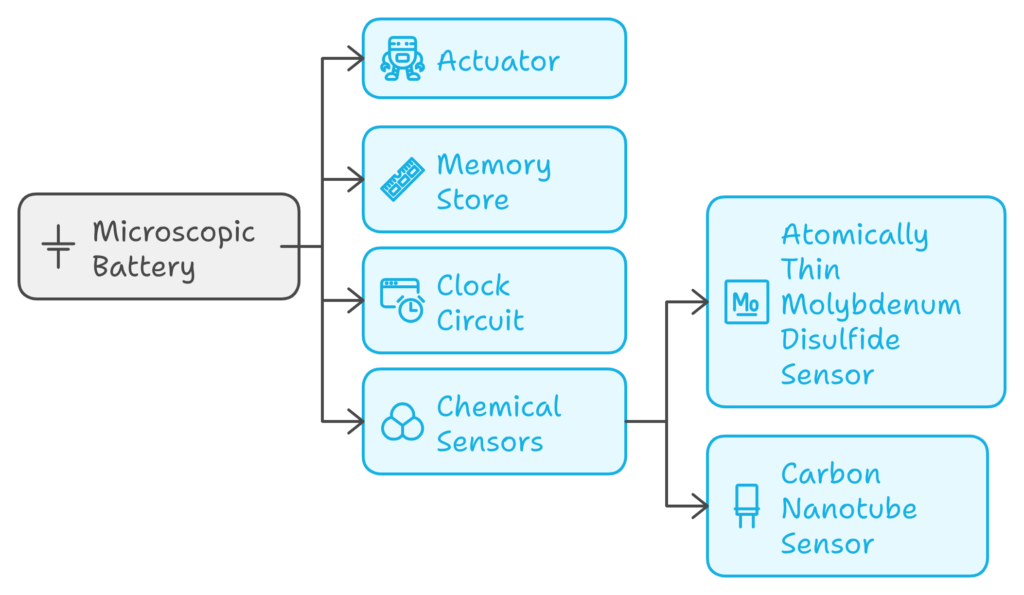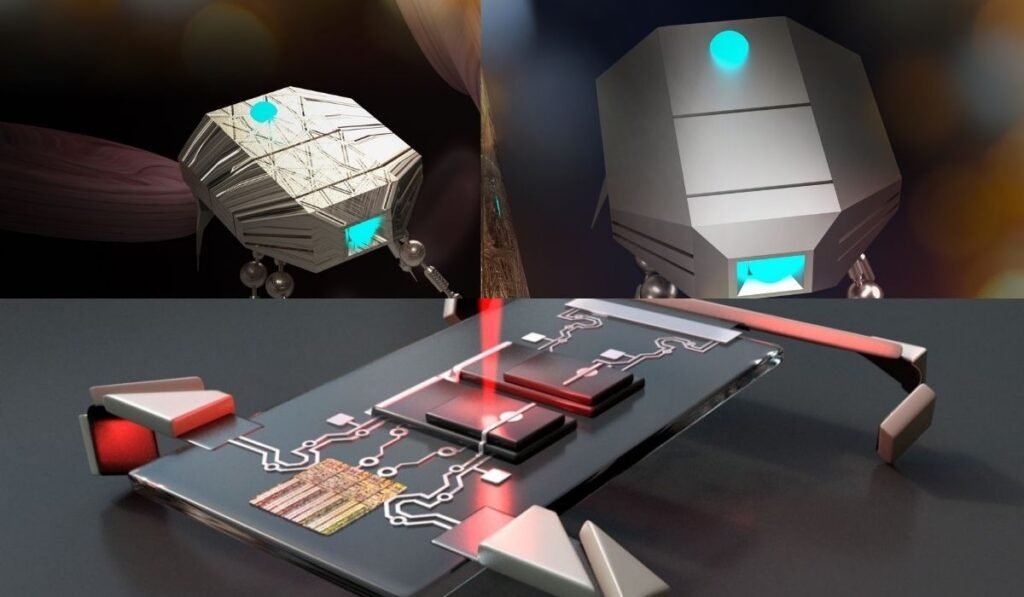Imagine tiny robots, smaller than a grain of rice, capable of performing intricate tasks inside your body without leaving a single scar. This futuristic concept is rapidly becoming a reality, thanks to groundbreaking advancements in nanotechnology and energy storage. Scientists are developing microscopic robots powered by invisible batteries, opening up exciting new possibilities in medicine, engineering, and environmental monitoring.
The Breakthrough: MIT’s Microscopic Battery
Engineers at MIT have developed a revolutionary new tiny battery that could transform the deployment of cell-sized autonomous robots for drug delivery within the human body. This battery is among the smallest ever designed and holds enormous potential for enabling previously impossible technological feats due to its minuscule size and impressive capabilities.

Key Features of the Microscopic Battery
- Size: 0.1 millimeters in length and 0.002 millimeters in thickness (comparable to a human hair)
- Power generation: Uses oxygen from surrounding air to oxidize zinc, generating electrical current
- Voltage: Achieves up to 1 volt, impressive for its microscopic scale
- Applications: Capable of powering tiny circuits, sensors, and actuators

This groundbreaking research was supported by several key institutions:
- U.S. Army Research Office
- U.S. Department of Energy
- National Science Foundation
- MathWorks Engineering Fellowship
The involvement of these organizations highlights the significance of developing innovative technologies like microscopic robots across various fields including defense, energy, and technology.
Potential Applications of Microscopic Robots
The applications of these battery-powered microscopic robots extend across multiple fields, with particularly exciting implications for medicine and industry:
Healthcare Revolution
- Precision medicine: Cell-sized autonomous robots could navigate through the human body to deliver drugs to specific locations
- Targeted treatment: Highly localized therapies for conditions like cancer, minimizing side effects
- Minimally invasive procedures: Potential for diagnostic and therapeutic applications without surgical incisions
Industrial Monitoring and Maintenance
- Infrastructure inspection: Microscopic robots deployed within gas pipelines to detect and pinpoint leaks in real-time
- Cost-effective solution: More efficient than traditional inspection methods
- Hard-to-reach areas: Ability to access and monitor spaces inaccessible to larger devices
Overcoming Robot Development Challenges
Creating a small yet powerful energy source for microscopic robots has been a significant engineering hurdle. Professor Michael Strano and his team at MIT have been working tirelessly to develop tiny robots capable of detecting and reacting to changes in their surroundings. The primary challenge they faced was finding a way to provide these robots with a steady and compact power source.
Limitations of Solar Power
Some researchers have attempted to use solar power for tiny devices, but this approach has significant drawbacks:
- Constant light source required (usually a laser)
- Limited independence and mobility
- Ineffective in dark or hard-to-reach places
The Need for Built-in Power
For microscopic robots to truly operate autonomously, especially in challenging environments, they require a built-in power source that doesn’t rely on external light. This need motivated Strano to create a zinc-air battery specifically designed for micro-robots.
The Zinc-Air Battery: A Game-Changing Innovation
Strano’s team made a crucial breakthrough by designing a zinc-air battery that is both small enough to fit within these micro-robots and capable of delivering the power needed for extended operation.
Advantages of the Zinc-Air Design
- Efficiency: Uses oxygen from the environment to react with zinc and produce electricity
- Compact: Doesn’t need to store oxygen inside the battery
- Lightweight: Ideal for integration into microscopic robots
This innovative battery design is a major step forward in micro-robotics, enabling devices that can operate independently in ways that were previously impossible.
Demonstrating the Power of Microscopic Robots
In their study, MIT researchers showcased the capabilities of their tiny battery by powering various components and devices:
- Actuator: Powered a small robotic arm that could be lifted up and down
- Memory store: Energized a device capable of storing information based on previous events
- Clock circuit: Enabled timing functions crucial for coordinating robotic tasks
- Chemical sensors:
- Atomically thin molybdenum disulfide sensor
- Carbon nanotube sensor

These successful tests demonstrate the versatility of the battery in powering a range of critical functions for microscopic robots, from controlling movement and storing information to sensing the environment and keeping track of time.
Future Potential and Research Directions
While the current study connected the tiny battery to external devices using wires, future work aims to integrate the battery directly into the design of small robots. This integration will make the battery an essential part of the device itself, similar to how electric cars are built around their power source.
Expanding Capabilities
Researchers are focused on increasing the battery’s voltage, which would allow microscopic robots to:
- Perform more complex tasks
- Power additional components
- Take on a wider range of applications
Medical Breakthroughs on the Horizon
One of the most exciting potential applications involves creating robots so small they could be injected into the human body. These microscopic robots could:
- Travel through the bloodstream
- Locate specific areas like damaged tissue or organs
- Deliver drugs (e.g., insulin) directly to the target site
To make this vision a reality, researchers are exploring:
- Biocompatible materials: Ensuring the robots are safe for use inside the human body
- Self-dissolving designs: Allowing the robots to break down naturally after completing their task
Challenges and Future Research
While the development of this tiny battery is a major milestone, further research is needed to refine its performance and expand its applications:
- Improving energy density
- Scaling up production
- Integrating batteries into fully autonomous micro-robots
- Advances in related fields:
- Robotics
- Artificial intelligence
- Materials science
As these technologies mature, the possibilities for cell-sized robots and their applications in both healthcare and industry could grow exponentially.
The Impact of Microscopic Robots on Various Industries
The potential impact of microscopic robots extends far beyond medicine and industrial monitoring. Let’s explore how these tiny machines could revolutionize other sectors:
Environmental Monitoring
Microscopic robots could play a crucial role in environmental conservation and protection:
- Water quality assessment: Deployed in rivers, lakes, and oceans to detect pollutants and monitor ecosystem health
- Soil analysis: Measuring nutrient levels and detecting contaminants to improve agricultural practices
- Air quality monitoring: Providing real-time data on pollutants and particulate matter in urban environments
Electronics and Computing
The integration of microscopic robots into electronic devices could lead to significant advancements:
- Self-repairing circuits: Tiny robots could identify and fix damaged components in electronic devices
- Enhanced data storage: Manipulating individual atoms to create ultra-high-density storage systems
- Quantum computing: Assisting in the precise manipulation of qubits for quantum information processing
Space Exploration
Microscopic robots could revolutionize space exploration by:
- Analyzing extraterrestrial samples: Providing detailed chemical and biological analysis of materials collected on other planets or moons
- Repairing spacecraft: Conducting intricate repairs on the internal and external components of space vehicles
- Terraforming assistance: Potentially playing a role in preparing other planets for human habitation by altering the environment at a microscopic level
Ethical Considerations and Societal Impact
As with any transformative technology, the development and deployment of microscopic robots raise important ethical considerations:
Privacy Concerns
The ability of these tiny machines to access previously inaccessible spaces could lead to privacy issues:
- Potential for unauthorized surveillance
- Need for robust regulations on the use and control of microscopic robots
Safety and Security
Ensuring the safety of microscopic robots, particularly those used in medical applications, is paramount:
- Rigorous testing protocols required
- Potential for misuse in biological warfare or terrorism
Socioeconomic Impact
The widespread adoption of microscopic robots could have far-reaching effects on society:
- Job displacement in certain industries
- Creation of new job categories and specializations
- Potential to exacerbate existing socioeconomic inequalities if access to the technology is limited
Preparing for a Future with Microscopic Robots
As microscopic robots move from the realm of science fiction to reality, it’s crucial for society to prepare for their integration:
Education and Training
- Developing new curricula to train the next generation of scientists and engineers in micro-robotics
- Educating the public about the potential benefits and risks of the technology
Policy and Regulation
- Establishing guidelines for the development, testing, and deployment of microscopic robots
- Creating international standards to ensure safe and ethical use across borders
Interdisciplinary Collaboration
- Fostering partnerships between researchers in robotics, materials science, medicine, and ethics
- Encouraging open dialogue between scientists, policymakers, and the public
A Tiny Revolution with Enormous Potential
The development of microscopic robots powered by tiny batteries represents a significant leap forward in technology. From revolutionizing medical treatments to transforming industrial processes and environmental monitoring, these miniature machines have the potential to reshape numerous aspects of our lives.
As research continues and the technology matures, we can expect to see increasingly sophisticated and capable microscopic robots emerging from laboratories around the world. While challenges remain in terms of further miniaturization, power efficiency, and addressing ethical concerns, the future of this field looks incredibly promising.
The journey from science fiction to reality is well underway, and microscopic robots are poised to usher in a new era of technological innovation. As we stand on the brink of this tiny revolution, it’s clear that the impact of these microscopic marvels will be anything but small.
Microscopic robots are tiny machines, smaller than a grain of rice, capable of performing intricate tasks, particularly in fields like medicine, engineering, and environmental monitoring.
Scientists at MIT have developed a microscopic battery that uses oxygen from surrounding air to oxidize zinc, generating an electrical current, which powers these tiny robots.
Microscopic robots can revolutionize healthcare by providing precision medicine, targeted treatment for conditions like cancer, and enabling minimally invasive procedures.
One of the main challenges is creating a small yet powerful energy source. Researchers have been working on solutions like the zinc-air battery to overcome this hurdle.
Solar power requires a constant light source and is limited in mobility and independence, making it ineffective in dark or hard-to-reach places.
Zinc-air batteries are efficient, compact, and lightweight, allowing for integration within microscopic robots while providing the power needed for extended operation.
They could be used for water quality assessment, soil analysis, and air quality monitoring, providing crucial data for environmental conservation.
Concerns include privacy issues due to unauthorized surveillance, safety in medical applications, and the socioeconomic impacts of widespread adoption.
Researchers aim to integrate batteries directly into the robots, increase voltage for more complex tasks, and explore biocompatible and self-dissolving materials for medical applications.
Preparation involves developing educational programs, establishing regulations and guidelines, and fostering interdisciplinary collaboration among researchers, policymakers, and the public.





